Objective 10. Design a Worksheet for What-If Analysis
Excel recalculates; if you change the value in a cell referenced in a formula, the result of the formula is automatically recalculated. Thus, you can change cell values to see what would happen if you tried different values. This process of changing the values in cells to see how those changes affect the outcome of formulas on the worksheet is called What-if analysis.
Activity 2.17. Calculating a Percentage Rate of Increase
Ms. French has the city's population figures for the first year of each decade for the past five decades. Each decade, the population has increased. In this activity, you will build a formula to calculate the percentage rate of increasethe percent by which one number increases over another numberfor each decade over the past 50 years. From this information, future population growth can be estimated.
|
1. |
Start Excel and Close |
||||||||||
|
2. |
In cell A3 type Population and press |
||||||||||
|
3. |
In cell A2, type Decade In cell B2, type 1960 and press Figure 2.42. 
By establishing a pattern of 10-year intervals with the first two cells, you can use the fill handle to continue the series. |
||||||||||
|
|
|||||||||||
|
4. |
Click cell A1. Type Past Population and press |
||||||||||
|
5. |
Beginning in cell B3 and pressing
|
||||||||||
|
6. |
Select the range B3:F3, apply the Comma Style |
||||||||||
|
7. |
Click cell C4. Type =(c3-b3)/b3 and press |
||||||||||
|
8. |
In the Formula Bar, notice the parentheses enclosing C3-B3. NoteExcel follows a mathematical rule called the order of operations, which has four basic parts:
|
||||||||||
|
9. |
Click cell D4, press Figure 2.43. (This item is displayed on page 740 in the print version) 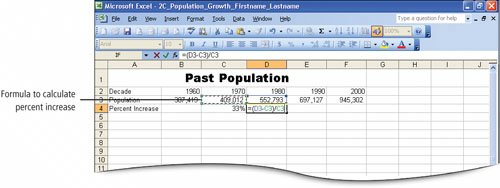
Recall that the first step is to determine the amount of increase1980 population minus 1970 populationand then to write the calculation so that Excel performs this operation first; that is, place it in parentheses. The second step is to divide the result of the calculation in parentheses by the basethe population for 1970. |
||||||||||
|
10. |
Press |
||||||||||
|
11. |
With cell D4 selected, drag the fill handle to the right through cell F4. Click any empty cell to cancel the selection, and then compare your screen with Figure 2.44. Figure 2.44. 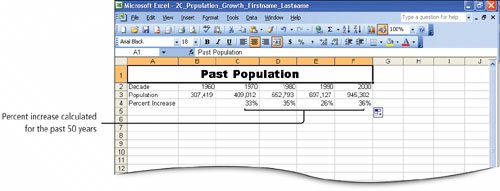
Because this formula uses relative cell referencesthat is, for each year, the formula is the same but the values used are relative to the formula's locationyou can copy the formula in this manner. For example, the result for 1980 uses 1970 as the base, the result for 1990 uses 1980 as the base, and the result for 2000 uses 1990 as the base. The formula results show the percent of increase for each decade between 1960 and 2000. You can see that each decade, the population has grown as much as 36%between 1990 and 2000and as little as 26%between 1980 and 1990. |
More Knowledge: Use of Parentheses in a Formula
When writing a formula in Excel, parentheses are used to communicate the order in which the operations should occur. For example, to average the grades you have received in a class, you would add the grades and then divide by the number of grades in the list. If you write this formula as =100+50+90/3, the results would be 180, because Excel would first divide 90 by 3 and then add 100+50+30. The correct way to write this formula is =(100+50+90)/3. In this example, Excel would add the three values, and then divide the result by 3, or 240/3 resulting in a correct average of 80. Parentheses play an important role in assuring that you get the correct results in your formulas.
Activity 2.18. Formatting as You Type
You can format numbers as you type them. When you type numbers in a format that Excel recognizes, Excel automatically applies that format to the cell. Recall that once applied, cell formats remain with the cell, even if the cell contents are deleted. In this activity, you will format cells by typing the numbers with percent signs and you will use the Format Painter to copy text (non-numeric) formats.
|
1. |
In cell A6 type Projected Population and press |
|
2. |
In cell A8 type Estimated Growth Rate and then press |
|
3. |
In cell A10 type Decade and in cell A11 type Projected Population In cell B10 type 2000 and then press Figure 2.45. 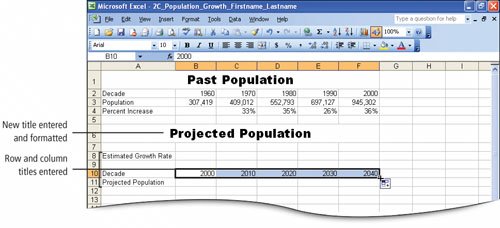
|
|
4. |
In cell B11, type 945,302 and on the Formula Bar click the Enter button |
|
5. |
Examine the format of the value in cell B11 and compare it to the format in cell B3 where you used the Comma Style button to format the cell. Notice that the number in cell B11 is flush with the right edge of the cell, but the number in cell B3 leaves a small space on the right edge. |
|
6. |
In cell B8, type 26% and on the Formula Bar click Enter |
|
7. |
Save |
More Knowledge: Percentage Calculations
When you type a percentage into a cell, for example 26%, the percentage format, without decimal points, displays in both the cell and the Formula Bar. However, Excel will use the 0.26 decimal value for actual calculations.
Activity 2.19. Calculating a Value After an Increase
A growing population results in increased use of streets, schools, and other city services. Thus, city planners in Desert Park must estimate how much the population will increase in the future. The calculations you made in the previous activity show that the population has increased at varying rates each decade, ranging from a low of 26% to a high of 36% per decade.
To plan for the future, Ms. French wants to prepare three forecasts of the city's population based on the lowest, highest, and average growth rates. In this activity, you will calculate the population increases that would result for the lowest rate of growth.
|
1. |
Click cell C11. Type =b11*(100%+$b$8) and then on the Formula Bar click Enter Figure 2.46. (This item is displayed on page 744 in the print version) 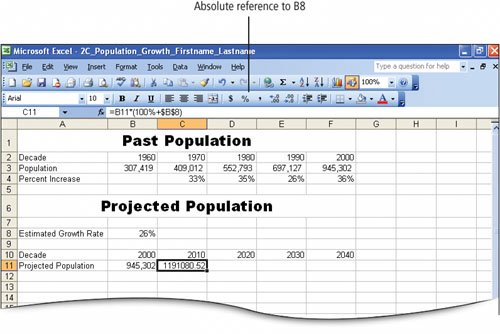
This formula calculates what the population will be in the year 2010 assuming an increase of 26% over 2000's population. The mathematical formula to calculate a value after an increase is value after increase = base x percent for new value. The first step is to establish the percent for new value. The percent for new value = base percent + percent of increase. The base percent of 100% represents the base population and the percent of increase in this instance is 26%. Thus, the population will equal 100% of the base year plus 26% of the base year. This can be expressed as 126% or 1.26. In this formula, you will use 100% + the rate in cell B8 to equal 126%. The second step is to enter a reference to the cell that contains the basethe population in 2000. This value resides in cell B11945,302. The third step is to calculate the value after increase. Because each decade's increase will be based on 26%an absolute value located in B8this cell reference can be formatted as absolute with the use of dollar signs. |
|
|
|
|
2. |
With cell C11 as the active cell, drag the fill handle to fill the formula into D11:F11. Click cell B11, click Format Painter Figure 2.47. (This item is displayed on page 745 in the print version) 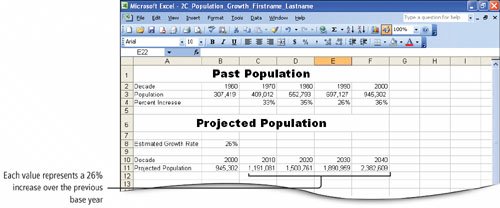
This formula uses a relative cell addressB11for the base; the population in the previous decade is used in each of the formulas in cells D11:F11 as the base value. Because the reference to the percent of increase in cell B8 is an absolute reference, each value after increase is calculated with the value from cell B8. The population projected for 20101,191,081is an increase of 26% over the population in 2000. The population in 20201,500,761is an increase of 26% over the population in 2010 and so on. |
|
|
|
|
3. |
Save |
More Knowledge: Calculating Percent Increase or Decrease
The basic formula for calculating an increase or decrease can be done in two parts. First determine the percent by which the base value will be increased or decreased, and then add or subtract the results to the base. The formula can be simplified by using (1+Amount of increase) or (1-Amount of decrease), where 1 represents the whole, rather than 100%. So the formula used in step 1 could also be written =b11*(1+$b$8), or =(b11*$b$8)+b11.
|
[Page 745 (continued)] Objective 11 Perform What If Analysis |
Windows XP
- Chapter One. Getting Started with Windows XP
- Project 1A. Windows XP
- Objective 1. Get Started with Windows XP
- Objective 2. Resize, Move, and Scroll Windows
- Objective 3. Maximize, Restore, Minimize, and Close a Window
- Objective 4. Create a New Folder
- Objective 5. Copy, Move, Rename, and Delete Files
- Objective 6. Find Files and Folders
- Objective 7. Compress Files
- Summary
- Key Terms
- Concepts Assessments
Outlook 2003
- Chapter One. Getting Started with Outlook 2003
- Getting Started with Microsoft Office Outlook 2003
- Project 1A. Exploring Outlook 2003
- Objective 1. Start and Navigate Outlook
- Objective 2. Read and Respond to E-mail
- Objective 3. Store Contact and Task Information
- Objective 4. Work with the Calendar
- Objective 5. Delete Outlook Information and Close Outlook
- Summary
- Key Terms
- Concepts Assessments
- Skill Assessments
- Performance Assessments
- Mastery Assessments
- Problem Solving
- GO! with Help
Internet Explorer
- Chapter One. Getting Started with Internet Explorer
- Getting Started with Internet Explorer 6.0
- Project 1A. College and Career Information
- Objective 1. Start Internet Explorer and Identify Screen Elements
- Objective 2. Navigate the Internet
- Objective 3. Create and Manage Favorites
- Objective 4. Search the Internet
- Objective 5. Save and Print Web Pages
- Summary
- Key Terms
- Concepts Assessments
- Skill Assessments
- Performance Assessments
- Mastery Assessments
- Problem Solving
Computer Concepts
- Chapter One. Basic Computer Concepts
- Objective 1. Define Computer and Identify the Four Basic Computing Functions
- Objective 2. Identify the Different Types of Computers
- Objective 3. Describe Hardware Devices and Their Uses
- Objective 4. Identify Types of Software and Their Uses
- Objective 5. Describe Networks and Define Network Terms
- Objective 6. Identify Safe Computing Practices
- Summary
- In this Chapter You Learned How to
- Key Terms
- Concepts Assessments
Word 2003
Chapter One. Creating Documents with Microsoft Word 2003
- Chapter One. Creating Documents with Microsoft Word 2003
- Getting Started with Microsoft Office Word 2003
- Project 1A. Thank You Letter
- Objective 1. Create and Save a New Document
- Objective 2. Edit Text
- Objective 3. Select, Delete, and Format Text
- Objective 4. Create Footers and Print Documents
- Project 1B. Party Themes
- Objective 5. Navigate the Word Window
- Objective 6. Add a Graphic to a Document
- Objective 7. Use the Spelling and Grammar Checker
- Objective 8. Preview and Print Documents, Close a Document, and Close Word
- Objective 9. Use the Microsoft Help System
- Summary
- Key Terms
- Concepts Assessments
- Skill Assessments
- Performance Assessments
- Mastery Assessments
- Problem Solving
- You and GO!
- Business Running Case
- GO! with Help
Chapter Two. Formatting and Organizing Text
- Formatting and Organizing Text
- Project 2A. Alaska Trip
- Objective 1. Change Document and Paragraph Layout
- Objective 2. Change and Reorganize Text
- Objective 3. Create and Modify Lists
- Project 2B. Research Paper
- Objective 4. Insert and Format Headers and Footers
- Objective 5. Insert Frequently Used Text
- Objective 6. Insert and Format References
- Summary
- Key Terms
- Concepts Assessments
- Skill Assessments
- Performance Assessments
- Mastery Assessments
- Problem Solving
- You and GO!
- Business Running Case
- GO! with Help
Chapter Three. Using Graphics and Tables
- Using Graphics and Tables
- Project 3A. Job Opportunities
- Objective 1. Insert and Modify Clip Art and Pictures
- Objective 2. Use the Drawing Toolbar
- Project 3B. Park Changes
- Objective 3. Set Tab Stops
- Objective 4. Create a Table
- Objective 5. Format a Table
- Objective 6. Create a Table from Existing Text
- Summary
- Key Terms
- Concepts Assessments
- Skill Assessments
- Performance Assessments
- Mastery Assessments
- Problem Solving
- You and GO!
- Business Running Case
- GO! with Help
Chapter Four. Using Special Document Formats, Columns, and Mail Merge
- Using Special Document Formats, Columns, and Mail Merge
- Project 4A. Garden Newsletter
- Objective 1. Create a Decorative Title
- Objective 2. Create Multicolumn Documents
- Objective 3. Add Special Paragraph Formatting
- Objective 4. Use Special Character Formats
- Project 4B. Water Matters
- Objective 5. Insert Hyperlinks
- Objective 6. Preview and Save a Document as a Web Page
- Project 4C. Recreation Ideas
- Objective 7. Locate Supporting Information
- Objective 8. Find Objects with the Select Browse Object Button
- Project 4D. Mailing Labels
- Objective 9. Create Labels Using the Mail Merge Wizard
- Summary
- Key Terms
- Concepts Assessments
- Skill Assessments
- Performance Assessments
- Mastery Assessments
- Problem Solving
- You and GO!
- Business Running Case
- GO! with Help
Excel 2003
Chapter One. Creating a Worksheet and Charting Data
- Creating a Worksheet and Charting Data
- Project 1A. Tableware
- Objective 1. Start Excel and Navigate a Workbook
- Objective 2. Select Parts of a Worksheet
- Objective 3. Enter and Edit Data in a Worksheet
- Objective 4. Construct a Formula and Use the Sum Function
- Objective 5. Format Data and Cells
- Objective 6. Chart Data
- Objective 7. Annotate a Chart
- Objective 8. Prepare a Worksheet for Printing
- Objective 9. Use the Excel Help System
- Project 1B. Gas Usage
- Objective 10. Open and Save an Existing Workbook
- Objective 11. Navigate and Rename Worksheets
- Objective 12. Enter Dates and Clear Formats
- Objective 13. Use a Summary Sheet
- Objective 14. Format Worksheets in a Workbook
- Summary
- Key Terms
- Concepts Assessments
- Skill Assessments
- Performance Assessments
- Mastery Assessments
- Problem Solving
- You and GO!
- Business Running Case
- GO! with Help
Chapter Two. Designing Effective Worksheets
- Designing Effective Worksheets
- Project 2A. Staff Schedule
- Objective 1. Use AutoFill to Fill a Pattern of Column and Row Titles
- Objective 2. Copy Text Using the Fill Handle
- Objective 3. Use AutoFormat
- Objective 4. View, Scroll, and Print Large Worksheets
- Project 2B. Inventory Value
- Objective 5. Design a Worksheet
- Objective 6. Copy Formulas
- Objective 7. Format Percents, Move Formulas, and Wrap Text
- Objective 8. Make Comparisons Using a Pie Chart
- Objective 9. Print a Chart on a Separate Worksheet
- Project 2C. Population Growth
- Objective 10. Design a Worksheet for What-If Analysis
- Objective 11. Perform What-If Analysis
- Objective 12. Compare Data with a Line Chart
- Summary
- Key Terms
- Concepts Assessments
- Skill Assessments
- Performance Assessments
- Mastery Assessments
- Problem Solving
- You and GO!
- Business Running Case
- GO! with Help
Chapter Three. Using Functions and Data Tables
- Using Functions and Data Tables
- Project 3A. Geography Lecture
- Objective 1. Use SUM, AVERAGE, MIN, and MAX Functions
- Objective 2. Use a Chart to Make Comparisons
- Project 3B. Lab Supervisors
- Objective 3. Use COUNTIF and IF Functions, and Apply Conditional Formatting
- Objective 4. Use a Date Function
- Project 3C. Loan Payment
- Objective 5. Use Financial Functions
- Objective 6. Use Goal Seek
- Objective 7. Create a Data Table
- Summary
- Key Terms
- Concepts Assessments
- Skill Assessments
- Performance Assessments
- Mastery Assessments
- Problem Solving
- You and GO!
- Business Running Case
- GO! with Help
Access 2003
Chapter One. Getting Started with Access Databases and Tables
- Getting Started with Access Databases and Tables
- Project 1A. Academic Departments
- Objective 1. Rename a Database
- Objective 2. Start Access, Open an Existing Database, and View Database Objects
- Project 1B. Fundraising
- Objective 3. Create a New Database
- Objective 4. Create a New Table
- Objective 5. Add Records to a Table
- Objective 6. Modify the Table Design
- Objective 7. Create Table Relationships
- Objective 8. Find and Edit Records in a Table
- Objective 9. Print a Table
- Objective 10. Close and Save a Database
- Objective 11. Use the Access Help System
- Summary
- Key Terms
- Concepts Assessments
- Skill Assessments
- Performance Assessments
- Mastery Assessments
- Problem Solving Assessments
- Problem Solving
- You and GO!
- Business Running Case
- GO! with Help
Chapter Two. Sort, Filter, and Query a Database
- Sort, Filter, and Query a Database
- Project 2A. Club Fundraiser
- Objective 1. Sort Records
- Objective 2. Filter Records
- Objective 3. Create a Select Query
- Objective 4. Open and Edit an Existing Query
- Objective 5. Sort Data in a Query
- Objective 6. Specify Text Criteria in a Query
- Objective 7. Print a Query
- Objective 8. Specify Numeric Criteria in a Query
- Objective 9. Use Compound Criteria
- Objective 10. Create a Query Based on More Than One Table
- Objective 11. Use Wildcards in a Query
- Objective 12. Use Calculated Fields in a Query
- Objective 13. Group Data and Calculate Statistics in a Query
- Summary
- Key Terms
- Concepts Assessments
- Skill Assessments
- Performance Assessments
- Mastery Assessments
- Problem Solving
- You and GO!
- Business Running Case
- GO! with Access Help
Chapter Three. Forms and Reports
- Forms and Reports
- Project 3A. Fundraiser
- Objective 1. Create an AutoForm
- Objective 2. Use a Form to Add and Delete Records
- Objective 3. Create a Form Using the Form Wizard
- Objective 4. Modify a Form
- Objective 5. Create an AutoReport
- Objective 6. Create a Report Using the Report Wizard
- Objective 7. Modify the Design of a Report
- Objective 8. Print a Report and Keep Data Together
- Summary
- Key Terms
- Concepts Assessments
- Skill Assessments
- Performance Assessments
- Mastery Assessments
- Problem Solving
- You and GO!
- Business Running Case
- GO! with Help
Powerpoint 2003
Chapter One. Getting Started with PowerPoint 2003
- Getting Started with PowerPoint 2003
- Project 1A. Expansion
- Objective 1. Start and Exit PowerPoint
- Objective 2. Edit a Presentation Using the Outline/Slides Pane
- Objective 3. Format and Edit a Presentation Using the Slide Pane
- Objective 4. View and Edit a Presentation in Slide Sorter View
- Objective 5. View a Slide Show
- Objective 6. Create Headers and Footers
- Objective 7. Print a Presentation
- Objective 8. Use PowerPoint Help
- Summary
- Key Terms
- Concepts Assessments
- Skill Assessments
- Performance Assessments
- Mastery Assessments
- Problem Solving
- You and GO!
- Business Running Case
- GO! with Help
Chapter Two. Creating a Presentation
- Creating a Presentation
- Project 2A. Teenagers
- Objective 1. Create a Presentation
- Objective 2. Modify Slides
- Project 2B. History
- Objective 3. Create a Presentation Using a Design Template
- Objective 4. Import Text from Word
- Objective 5. Move and Copy Text
- Summary
- Key Terms
- Concepts Assessments
- Skill Assessments
- Performance Assessments
- Mastery Assessments
- Problem Solving
- You and GO!
- Business Running Case
- GO! with Help
Chapter Three. Formatting a Presentation
- Project 3A. Emergency
- Objective 1. Format Slide Text
- Objective 2. Modify Placeholders
- Objective 3. Modify Slide Master Elements
- Objective 4. Insert Clip Art
- Project 3B. Volunteers
- Objective 5. Apply Bullets and Numbering
- Objective 6. Customize a Color Scheme
- Objective 7. Modify the Slide Background
- Objective 8. Apply an Animation Scheme
- Summary
- Key Terms
- Concepts Assessments
- Skill Assessments
- Performance Assessments
- Mastery Assessments
- Problem Solving
- You and GO!
- Business Running Case
- GO! with Help
Integrated Projects
Chapter One. Using Access Data with Other Office Applications
- Chapter One. Using Access Data with Other Office Applications
- Introduction
- Project 1A. Meeting Slides
- Objective 1. Export Access Data to Excel
- Objective 2. Create a Formula in Excel
- Objective 3. Create a Chart in Excel
- Objective 4. Copy Access Data into a Word Document
- Objective 5. Copy Excel Data into a Word Document
- Objective 6. Insert an Excel Chart into a PowerPoint Presentation
Chapter Two. Using Tables in Word and Excel
- Chapter Two. Using Tables in Word and Excel
- Introduction
- Project 2A. Meeting Notes
- Objective 1. Plan a Table in Word
- Objective 2. Enter Data and Format a Table in Word
- Objective 3. Create a Table in Word from Excel Data
- Objective 4. Create Excel Worksheet Data from a Word Table
Chapter Three. Using Excel as a Data Source in a Mail Merge
- Chapter Three. Using Excel as a Data Source in a Mail Merge
- Introduction
- Project 3A. Mailing Labels
- Objective 1. Prepare a Mail Merge Document as Mailing Labels
- Objective 2. Choose an Excel Worksheet as a Data Source
- Objective 3. Produce and Save Merged Mailing Labels
- Objective 4. Open a Saved Main Document for Mail Merge
Chapter Four. Linking Data in Office Documents
- Chapter Four. Linking Data in Office Documents
- Introduction
- Project 4A. Weekly Sales
- Objective 1. Insert and Link in Word an Excel Object
- Objective 2. Format an Object in Word
- Objective 3. Open a Word Document That Includes a Linked Object, and Update Links
Chapter Five. Creating Presentation Content from Office Documents
EAN: 2147483647
Pages: 448
 the Getting Started task pane. From the File menu, click Save As. In the Save As dialog box, navigate to the drive and folder where you are storing your projects for this chapter. In the File name box, type 2C_Population_Growth_Firstname_Lastname and then click Save or press
the Getting Started task pane. From the File menu, click Save As. In the Save As dialog box, navigate to the drive and folder where you are storing your projects for this chapter. In the File name box, type 2C_Population_Growth_Firstname_Lastname and then click Save or press  .
. pointer, and then double-click to AutoFit the column to accommodate its longest entry. Alternatively, from the Format menu, point to Column, and then click AutoFit Selection.
pointer, and then double-click to AutoFit the column to accommodate its longest entry. Alternatively, from the Format menu, point to Column, and then click AutoFit Selection. . In cell C2 type 1970 and press
. In cell C2 type 1970 and press  button, change the Font
button, change the Font  to Arial Black and the Font Size
to Arial Black and the Font Size  to 18.
to 18. , and then click Decrease Decimal
, and then click Decrease Decimal  two times.
two times. , and then look at the formula in the Formula Bar.
, and then look at the formula in the Formula Bar. , and then by either typing or clicking cells, construct a formula similar to the one in cell C4 to calculate the rate of increase in population from 1970 to 1980. Then, compare your screen with Figure 2.43.
, and then by either typing or clicking cells, construct a formula similar to the one in cell C4 to calculate the rate of increase in population from 1970 to 1980. Then, compare your screen with Figure 2.43. , and then click cell A6.
, and then click cell A6. so that the cell remains selected. Then, press
so that the cell remains selected. Then, press  and without typing a comma, type 945302 and press
and without typing a comma, type 945302 and press  your workbook.
your workbook.